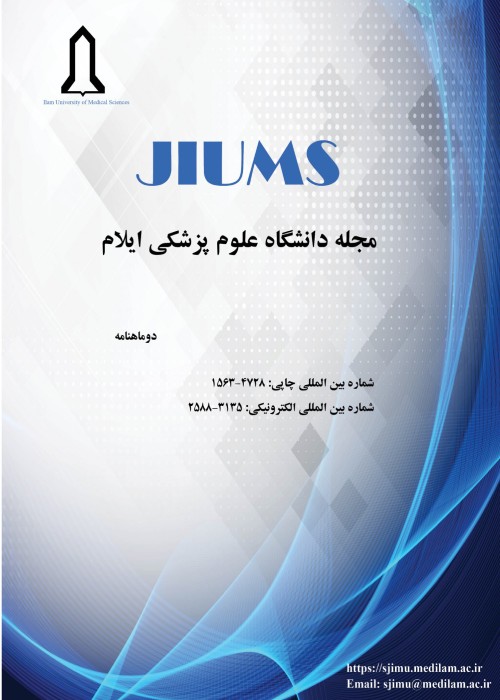Green synthesis of silver nanoparticles using aqueous seed extract of Cuminum cyminum L. and evaluation of their biological activities
Author(s):
Article Type:
Research/Original Article (دارای رتبه معتبر)
Abstract:
Introduction
There are many reports on the application of medicinal plants in traditional medicine, as well as numerous applications of metallic nanoparticles in different biomedical fields. Plant extract mediated green synthesis of nanoparticles and investigations on their therapeutic effects are new concepts. The medicinal plant of Cuminum cyminum L. includes a wide range of secondary metabolites with a high reducing power, which can be used for green biosynthesis of silver nanoparticles. The main aims of this study were phytochemical analysis of seed aqueous extract of Cuminum cyminum, biosynthesis of silver nanoparticles using this extract, the achievement of optimization condition for the synthesis of silver nanoparticles, and assessment of biological activaties of both the extract and the synthesized nanoparticles.Materials & Methods
Total phenol and flavonoid, reducing sugar, starch, and ascorbic acid contents were measured by Folin-Ciocalteo, aluminum chloride, dinitrosalicylic acid, anthrone, and dinitrophenyl hydrazine reagents, respectively. The Ag+ ions reduction and characterization of silver nanoparticles were assessed by UV-Visible spectrophotometry, X-ray diffraction, Fourier transform infrared spectroscopy, and scanning electron microscopy. Antioxidant activity of the samples was screened by DPPH free radical scavenging. Antibacterial activity of the samples was also evaluated against four gram-positive and -negative bacteria namely, Bacillus cereus (PTCC 1247), Staphylococcus aureus (ATCC 25923), Escherichia coli (ATCC 35218), and Pseudomonas aeruginosa (ATCC 27853) by disc diffusion method. In addition, antifungal activity was assessed against Fusarium oxysporum.Findings
The indings indicated that the seed extract contained the high amounts of total phenolic and flavonoidic compositions, as well as sugar, starch, and ascorbic acid. Different analyses showed that the mean size of the synthesized nanoparticles was 5-45 nm in the optimal condition. The samples had proper antioxidant potential (IC50=1.35-1.67 mg/ml) and the extract in combination with silver nanoparticles represented synergistic effect in DPPH free radical scavenging (IC50=1.35 mg/ml). In addition, the investiogated samples had a good antibacterial activity against some of tested bacteria and also antifungal activity against Fusarium oxysporum.Discussion &
Conclusions
It seems that the secondary metabolites of Cuminum cyminum have good potential for the reduction and stabilization of the synthesized Ag nanoparticles. Both the seed extract and synthesized nanoparticles using this extract have considerable biological activities and may be used in antioxidant nutrient production or medicinal supplements in future.Keywords:
Language:
Persian
Published:
Ilam University of Medical Science, Volume:26 Issue: 5, 2018
Pages:
128 to 141
magiran.com/p1930133
دانلود و مطالعه متن این مقاله با یکی از روشهای زیر امکان پذیر است:
اشتراک شخصی
با عضویت و پرداخت آنلاین حق اشتراک یکساله به مبلغ 1,390,000ريال میتوانید 70 عنوان مطلب دانلود کنید!
اشتراک سازمانی
به کتابخانه دانشگاه یا محل کار خود پیشنهاد کنید تا اشتراک سازمانی این پایگاه را برای دسترسی نامحدود همه کاربران به متن مطالب تهیه نمایند!
توجه!
- حق عضویت دریافتی صرف حمایت از نشریات عضو و نگهداری، تکمیل و توسعه مگیران میشود.
- پرداخت حق اشتراک و دانلود مقالات اجازه بازنشر آن در سایر رسانههای چاپی و دیجیتال را به کاربر نمیدهد.
دسترسی سراسری کاربران دانشگاه پیام نور!
اعضای هیئت علمی و دانشجویان دانشگاه پیام نور در سراسر کشور، در صورت ثبت نام با ایمیل دانشگاهی، تا پایان فروردین ماه 1403 به مقالات سایت دسترسی خواهند داشت!
In order to view content subscription is required
Personal subscription
Subscribe magiran.com for 70 € euros via PayPal and download 70 articles during a year.
Organization subscription
Please contact us to subscribe your university or library for unlimited access!


